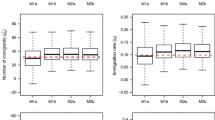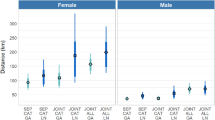Abstract
We examine the performance of a method of integrated population modelling for the joint analysis of different types of demographic data on individuals that exist in, and move between, different sites. The value of the approach is demonstrated by a simulation study which shows substantial improvement in parameter estimation when site-specific census data are combined with demographic data. The multivariate normal approximation to a multi-state mark-recapture likelihood is evaluated, and the performance of a diagonal variance-covariance matrix for the approximation is also examined. The work is motivated by a study of great cormorants. Analysis of the cormorant data suggests that breeders survive better than non-breeders, and also that probabilities of recruitment to breeding have been declining over time for all the colonies of the study. Supplementary material, including notes on the computation of standard errors and extended simulation results, are available online.
Similar content being viewed by others
References
Arnason, A. N. (1972), “Parameter Estimates from Mark-Recapture-Recovery Experiments on Two Populations Subject to Migration and Death,” Researches on Population Ecology, 13, 97–113.
Arnason, A. N. (1973), “The Estimation of Population Size, Migration Rates, and Survival in a Stratified Population,” Researches on Population Ecology, 15, 1–8.
Besbeas, P., and Morgan, B. J. T. (2009), “Integrated Population Model Selection,” Technical Report.
Besbeas, P., and Morgan, B. J. T. (2010), “Kalman Filter Initialization for Modelling Population Dynamics,” Panagiotis Technical Report UKC/IMS/06/025, SMSAS, University of Kent, UK.
Besbeas, P., Lebreton, J. D., and Morgan, B. J. T. (2003), “The Efficient Integration of Abundance and Demographic Data,” Applied Statistics, 52, 95–102.
Besbeas, P., Borysiewicz, R. S., and Morgan, B. J. T. (2009), “Completing the Ecological Jigsaw,” Environmental and Ecological Statistics, 3, 513–540. Edited by Thomson, D. L., Cooch, E. G., and Conroy, M. J.
Besbeas, P., Freeman, S. N., Morgan, B. J. T., and Catchpole, E. A. (2002), “Integrating Mark-Recapture-Recovery and Census Data to Estimate Animal Abundance and Demographic Parameters,” Biometrics, 58, 540–547.
Borysiewicz, R. S. (2008), “The Combined Analysis of Multi-Site Mark-Recapture-Recovery Data and Multi-Site Census Data,” Ph.D. thesis, University of Kent.
Borysiewicz, R. S., Morgan, B. J. T., Hénaux, V., Bregnballe, T., Lebreton, J. D., and Gimenez, O. (2009), “An Integrated Analysis of Multi-Site Recruitment, Mark-Recapture-Recovery and Multi-Site Census Data,” Environmental and Ecological Statistics, 3, 579–591. Edited by Thomson, D. L., Cooch, E. G., and Conroy, M. J.
Bregnballe, T. (1995), “Cormorant Research in Denmark,” Cormorant Research Group Bulletin, 1, 4–7.
Bregnballe, T. (2006), “Age-Related Fledgling Production in Great Cormorants Phalacrocorax Carbo: Influence of Individual Competence and Disappearance of Phenotypes,” Journal of Avian Biology, 37, 149–157.
Bregnballe, T., and Frederiksen, M. (2006), “Net-Entrapment of Great Cormorants Phalacrocorax Carbo Sinensis in Relation to Age and Population Size,” Wildlife Biology, 12, 143–150.
Bregnballe, T., and Gregersen, J. (2003), “Within-Colony Variation in Breeding Success in a Great Cormorant Colony in Denmark,” Die Vogelwelt, 124, 115–122.
Bregnballe, T., and Rasmussen, T. (2000), “Post-Breeding Dispersal of Great Cormorants Phalacrocorax Carbo Sinensis from Danish Breeding Colonies,” Dansk Ornitologisk Forenings Tidsskrift, 94, 175–187.
Bregnballe, T., Frederiksen, M., and Gregersen, J. (1997), “Seasonal Distribution and Timing of Migration of Cormorants Phalacrocorax Carbo Sinensis Breeding in Denmark,” Bird Study, 44, 257–276.
Brownie, C., Hines, J. E., Nichols, J. D., Pollock, K. H., and Hestbeck, J. B. (1993), “Capture-Recapture Studies for Multiple Strata Including Non-Markovian Transitions,” Biometrics, 49, 1173–1187.
Buckland, S. T., Newman, K. B., Thomas, L., and Koesters, N. B. (2004), “State Space Models for the Dynamics of Wild Animal Populations,” Ecological Modelling, 171, 157–175.
Burnham, K. P., and Anderson, D. R. (2002), Model Selection and Multimodel Inference: A Practical Information Theoretic Approach (2nd ed.), New York: Springer.
Caswell, H. (2000) Matrix Population Models: Construction, Analysis and Interpretation (2nd ed.), Sunderland: Sinauer.
Choquet, R., Reboulet, A. M., Pradel, R., Gimenez, O., and Lebreton, J. D. (2003), User’s Manual for U-Care, Mimeographed document, CEFE/CNRS, Montpellier, France.
Choquet, R., Reboulet, A. M., Pradel, R., Gimenez, O., and Lebreton, J. D. (2004), “M-Surge: New Software Specifically Designed for Multistate Capture-Recapture Models,” Animal Biodiversity and Conservation, 27, 207–215.
Cormack, R. M. (1964), “Estimates of Survival from Sightings of Marked Animals,” Biometrika, 51, 429–438.
Durbin, J., and Koopman, S. J. (2001), Time Series Analysis by State Space Methods, Oxford: Oxford University Press.
Frederiksen, M., and Bregnballe, T. (2001), “Conspecific Reproductive Success Affects Age of Recruitment in a Great Cormorant, Phalacrocorax Carbo Sinensis, Colony,” Proceedings of the Royal Society of London: Biological Sciences, 268, 1519–1526.
Frederiksen, M., Lebreton, J. D., and Bregnballe, T. (2001), “The Interplay Between Culling and Density-Dependence in the Great Cormorant: A Modelling Approach,” Journal of Applied Ecology, 38, 617–627.
Gauthier, G., Besbeas, P., Lebreton, J. D., and Morgan, B. J. T. (2007), “Population Growth in Greater Snow Geese: A Modeling Approach to Integrating Demographic and Population Survey Information,” Ecology, 88, 1420–1429.
Harvey, A. C. (1989), Forecasting, Structural Time Series Models and the Kalman Filter, Cambridge: Cambridge University Press.
Hénaux, V., Bregnballe, T., and Lebreton, J. D. (2007), “Dispersal and Recruitment During Population Growth in a Colonial Bird, the Great Cormorant,” Journal of Avian Biology, 38, 44–57.
Jolly, G. M. (1965), “Explicit Estimates from Capture-Recapture Data with Both Death and Imigration-Stochastic Models,” Biometrika, 52, 225–247.
Lebreton, J.-D., Almeras, T., and Pradel, R. (1999), “Competing Events, Mixtures of Information and Multistratum Recapture Models,” Bird Study, 46, S39–S46.
McCrea, R. S., Morgan, B. J. T. and Bregnballe, T. (2009), “One Size Fits All?,” Technical Report UKC/IMS/09/032, IMSAS, University of Kent, UK.
McCrea, R. S., and Morgan, B. J. T. (2010), “Multi-Site Mark-Recapture Model Selection Using Score Tests,” Biometrics. doi:10.1111/j.1541-0420.2010.01421.x.
Newman, K. B., Buckland, S. T., Lindley, S. T., Thomas, L., and Fernandez, C. (2006), “Hidden Process Models for Animal Population Dynamics,” Ecological Applications, 16, 74–86.
Reynolds, T. J., King, R., Harwood, J., Frederiksen, M., Harris, M. P., and Wanless, S. (2009), “Integrated Data Analysis in the Presence of Emigration and Tag Loss,” Journal of Agricultural, Biological and Environmental Statistics, 14, 411–431.
Schaub, M., Gimenez, O., Sierro, S., and Arlettaz (2007), “Assessing Population Dynamics from Limited Data with Integrated Modeling: Life History of the Endangered Greater Horseshoe Bat,” Conservation Biology, 21, 945–955.
Schwarz, C. G., Schweigert, J. F., and Arnason, A. N. (1993), “Estimating Migration Rates Using Tag-Recovery Data,” Biometrics, 59, 291–318.
Seber, G. A. F. (1965), “A Note on the Multiple-Recapture Census,” Biometrika, 52, 249–259.
Tavecchia, G., Besbeas, P., Morgan, B. J. T., and Coulson, T. (2009), “Hidden Demographic Processes and Population Estimates Through State-Space Modelling,” American Naturalist, 173, 722–733.
White, G. C., and Burnham, K. P. (1999), “Program MARK: Survival Estimation from Populations of Marked Animals,” Bird Study, 46, S120–S138.
Williams, B. K., Nichols, J. D., and Conroy, M. J. (2001) Analysis and Management of Animal Populations, San Diego: Academic Press.
Author information
Authors and Affiliations
Corresponding author
Electronic Supplementary Material
Below is the link to the electronic supplementary material.
Rights and permissions
About this article
Cite this article
McCrea, R.S., Morgan, B.J.T., Gimenez, O. et al. Multi-Site Integrated Population Modelling. JABES 15, 539–561 (2010). https://doi.org/10.1007/s13253-010-0027-5
Accepted:
Published:
Issue Date:
DOI: https://doi.org/10.1007/s13253-010-0027-5




